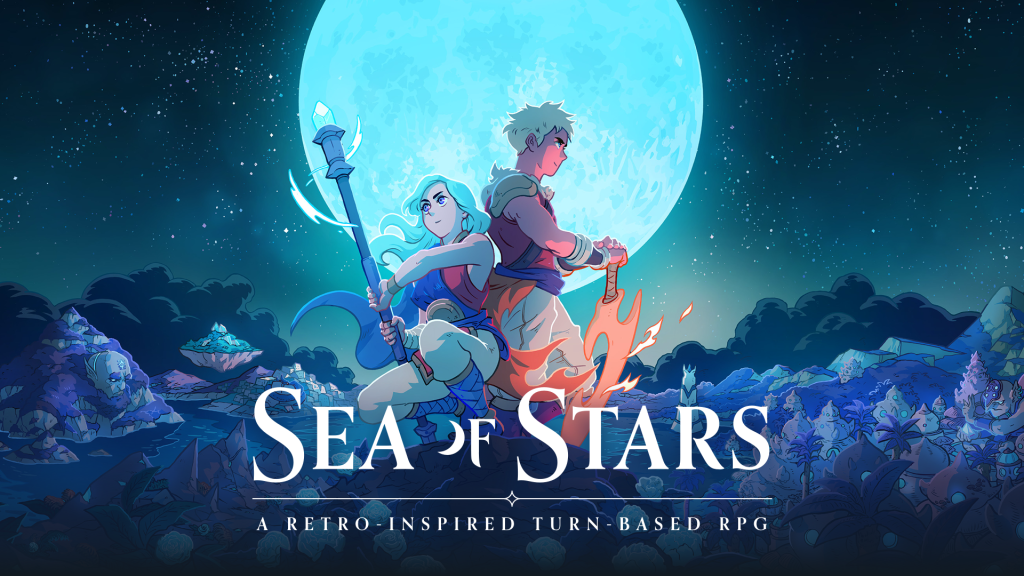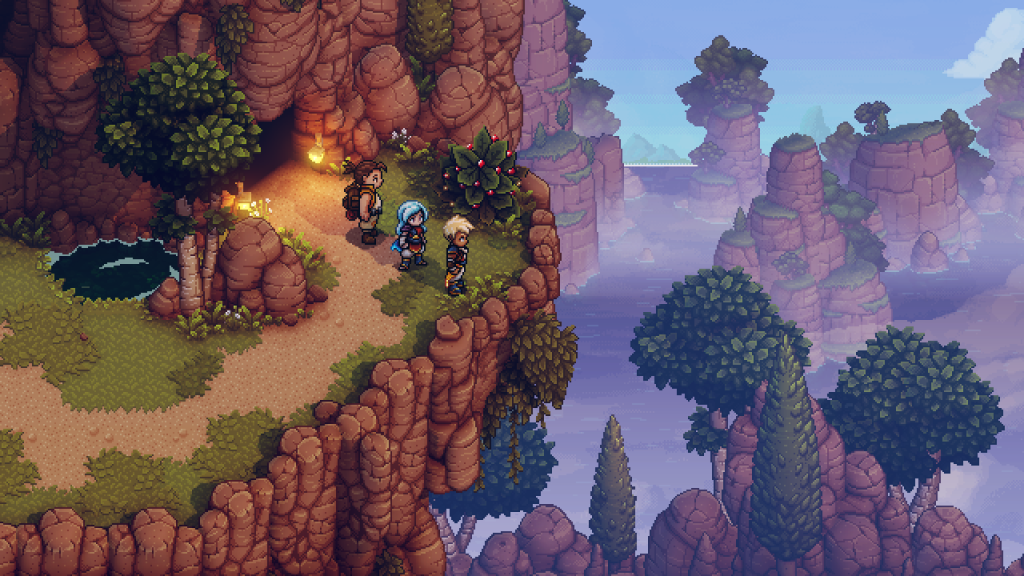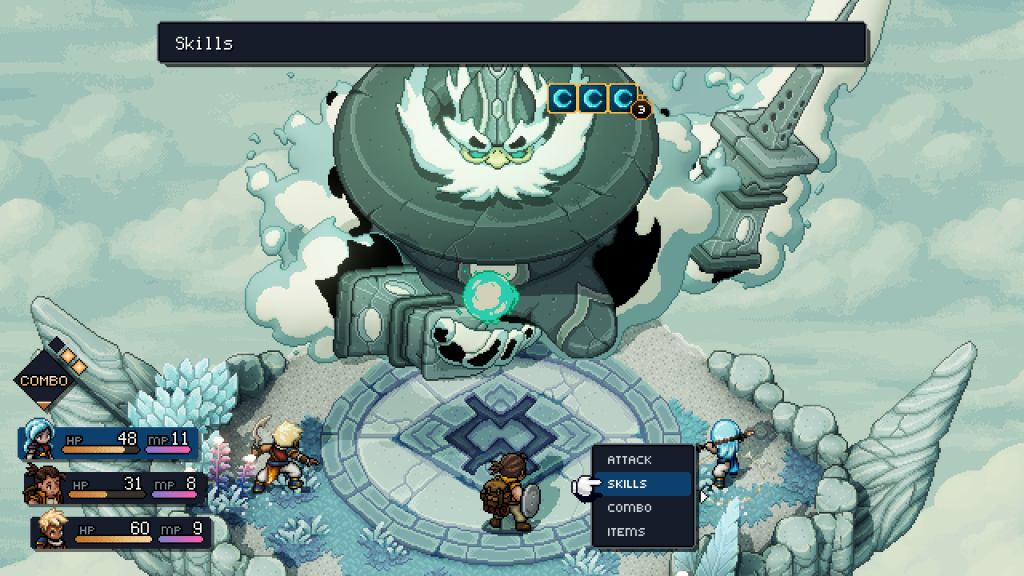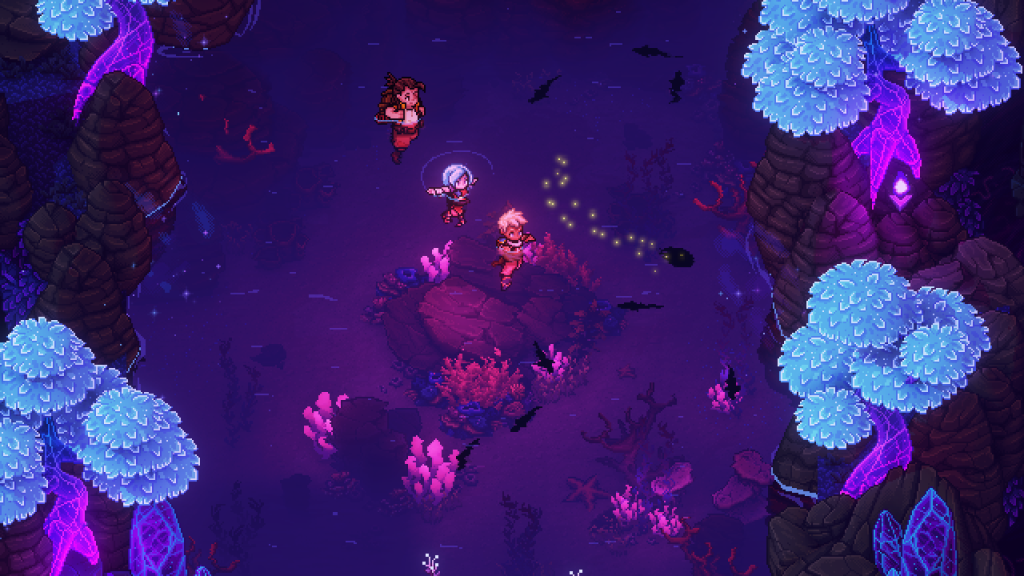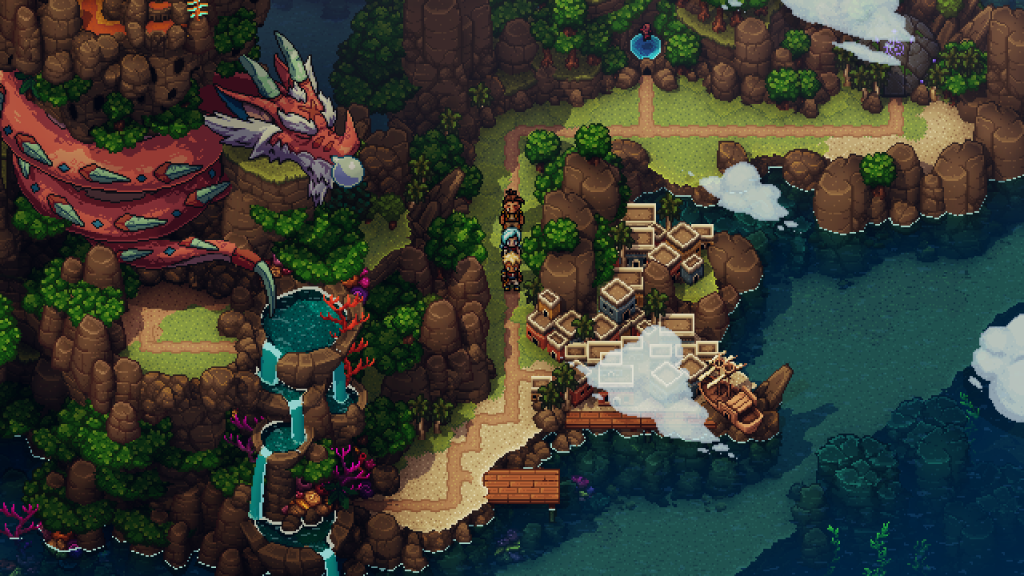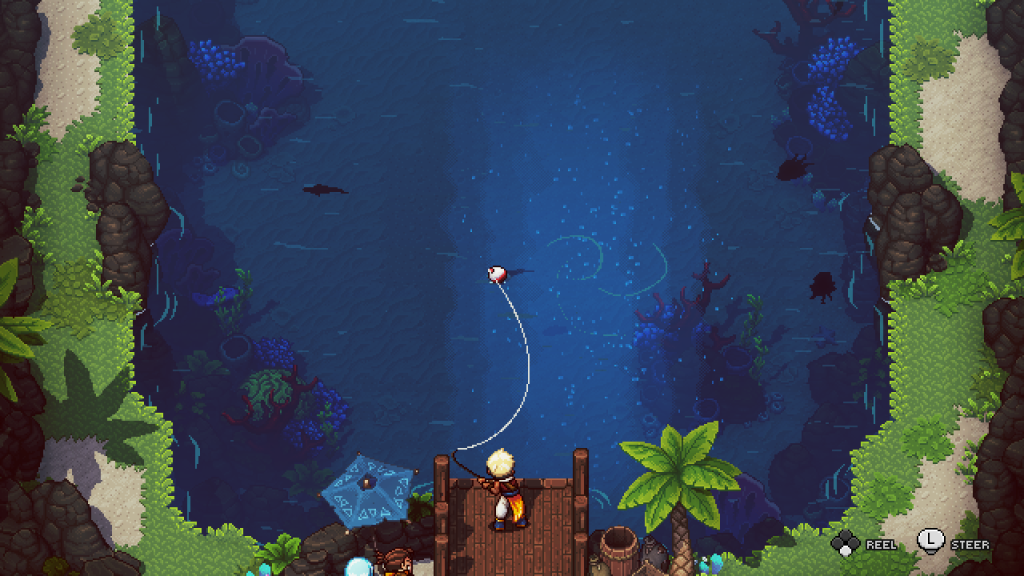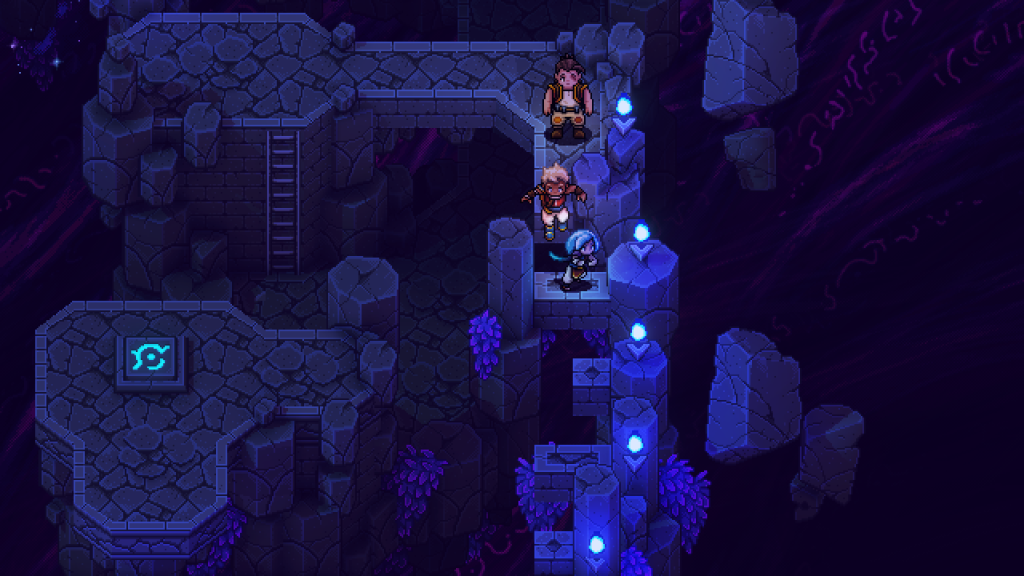Sea of Stars is developer Sabotage Studio’s follow-up to their exceptionally fun retro platformer The Messenger (2018). While The Messenger was their take on classic 8 and 16-bit platformers of the age, Sea of Stars is their attempt to make an old-school turn-based RPG ala Chrono Trigger. One glance at the game will tell you exactly what they’re going for, but is the game worthy of its influences, or does it fall short of holding a candle to the classics?
You play as Zale and Valere, Solstice Warriors who control the power of the sun and moon, respectively. You pick one character who will lead the party, but this choice really doesn’t have any tangible impact, for all intents and purposes they are dual protagonists. In this world, Solstice Warriors are raised to fight Dwellers, evil monstrosities of immense power that the infamous Fleshmancer has brought into being. The story begins with Zale and Valere completing the final trial of their decades-long training.
True to their word, Sea of Stars evokes an SNES-era RPG, through and through. Alongside your party, you will journey across a beautiful world map exploring quirky towns and puzzle-filled dungeons, engage in modernised turn-based combat against all manner of foes, and of course, meet many charming allies along the way.
The visuals on display here have absolutely raised the bar for pixel-art-style throwbacks like this. Sea of Stars is gorgeous. Vegetation moves in the breeze, fog deforms as your characters move through it, and there are even brief, fully animated (and stunning) cutscenes at key story moments. The game also features completely dynamic lighting, which just looks phenomenal in action. Whether it’s a blue or red magical blast casting its own light and shadows in combat or the cozy flickering of a campfire at night, this lighting engine elevates Sea of Stars’ visuals to a whole other level.
The art design is similarly impressive. Each level and town has a distinct, memorable aesthetic. The main characters, both those who join your party and those you simply meet along the way, all have their own unique style and silhouette. Some even feel like they could head up a game of their own. The same is true of this world’s many villains and monsters. Whether it’s a bumbling necromancer or a giant worm that fills the top half of your screen, all have their own animations and art that ranges from hilarious to downright terrifying.
Combat is where you’ll be spending the vast majority of your time. Three party members can take the field at any one time, however, as your party grows you can actually swap them out mid-battle without it taking up that character’s turn. You have regular attacks, skills, and character combos, and later on, ultimate attacks which are akin to summons from Final Fantasy, and just as spectacular. When an enemy begins to charge up a powerful spell, a series of icons will appear above their head indicating weaknesses. If you line up your attacks to exploit each of these weaknesses, the enemy’s spell will be canceled.
What I’ve described so far is fairly standard for a modern take on a turn-based RPG, but Sabotage Studio has tried to incorporate a few new elements in Sea of Stars’ combat. For example, when one of your crew hits zero HP they will be knocked unconscious, with cartoony stars swirling above their head. More than a stylistic choice, these stars are actually a countdown to when that character will be able to rejoin the fray. Each turn that passes a star will disappear until that character is revived at 50% HP. Of course, if all three of your characters get knocked out at the same time you will get a game over.
Another rather forgiving element is that regular attacks restore MP. This means that managing health and mana is far less burdensome in Sea of Stars when compared to other RPGs, even other modern reimaginings. Stocking up on restorative food items and timing your healing spells are both still super important, but in general, getting a game over is a pretty rare occurrence.
Perhaps the most interesting thing Sea of Stars does with its combat is actually have you time your button presses for both attacking and blocking. Valere’s moonerang skill for example, has you pressing a button to deflect the spell bouncing off your enemy, sending it back at them again. This gets faster and faster, like Link and Ganondorf playing tennis at the end of Ocarina of Time, and does more damage the longer you keep the rally going.
This works for other character’s skills too. Zale’s sunball has you hold down a button to charge it up, and if you release the button at the right time you’ll do extra damage. You can also press a button to block incoming damage if you time it right. There’s a lot more of these active mechanics and while it keeps things way more engaging than your average turn-based RPG, it can feel like a chore at times. When so much of what you do in Sea of Stars is combat, it occasionally becomes tedious to deploy these spells that feel like mini-games in their own right. Sometimes I want a fireball to just be a fireball, you know?
This manual element to the combat is exacerbated by sections of the game that restrict the number of party members available to you, or throw enemies at you with very specific weaknesses. There were one or two sections that really felt like a slog because I simply wasn’t able to counter my adversary’s weaknesses as effectively anymore. The challenge here, assuming that was what was intended, feels arbitrary and restrictive, rather than enjoyable.
Traversal is another element that has been dragged into the 21st Century. Instead of having to wind your way up and down set paths in a 2D environment, Sea of Stars features fluid level design that allows your characters to drop down or climb up cliff edges, create shortcuts with ladders, cruise down rivers, and more. It’s quite novel to have so much freedom of movement in a 2D game of this kind and makes exploration a breeze.
The puzzles and overall level design make great use of this freeform traversal. I was reminded multiple times of Golden Sun, you can jump gaps, push blocks into place, swim down rivers, climb vines, and much more as you progress through the story. The puzzles remain simple throughout, perhaps overly so, but remain a satisfying way to break up the story moments and combat.
The main narrative keeps things interesting for the most part. There were certain sections of the game that felt a little slow, a mix of the narrative dragging a little, and as I’ve mentioned the combat in these sections feeling particularly repetitive. Yet when taken as a whole the scope of this game is truly ambitious. Chrono Trigger was clearly their main influence here, and while invoking that title is a very loaded thing to do, it’s clear that it had a huge impact on Sea of Stars’ narrative. The sheer number of characters you meet and wildly different places you go is jaw-dropping.
Sea of Stars captures that wonderful, and these days elusive, feeling from old-school RPGs where your party arrives at a new town that has its own aesthetic, music, characters, and story arc to uncover. An example from fairly early on is when you come across the town of the Molekin. They’re in a tizzy because a wizard has been causing trouble in the nearby mines. So, of course, you and your party venture into the mine, fight some beasts, and have a chat with the wizard. Once you emerge the Molekin are thrilled, a few short side quests open up, and you can continue on your main adventure. It’s straightforward stuff but it just feels so great to play a game that is happy to slow down for these little self-contained adventures.
On a more micro level, the writing can be a little stilted at times, which I found with The Messenger, too. The syntax is just a little jarring now and then. Additionally, the two protagonists, Zale and Valere, are about as one-dimensional as you can possibly imagine. Beyond what you’re given at the start of the game (that they grew up in the same town together, they’re Solstice Warriors, and their best friend is a non-magical boy named Garl) they’re never really given any depth or development. They at least avoid being actively annoying, so there’s that.
As your quest goes on, there are a bunch of side activities to do, although they do take a while to open up. I had a lot of fun completing every collectathon, mini-game, and side quest. There’s fishing, a series of quizzes, hidden rainbow conches to find, music sheets to collect, a whole in-world board game of sorts called Wheels, and a lot more. Some of the side quests only become available after beating the game once, and completing all of those has a special reward.
The soundtrack is as impressive as it is voluminous. Sea of Stars features a lot of music. Guest Composer Yasunori Mitsuda, known for his work on Chrono Trigger and more recently the Xenoblade Chronicles series, is a wonderful addition here. Many of the tracks feel like they could’ve been ripped directly from an unreleased SNES classic. These nostalgic songs are accompanied by Eric W. Brown’s more punchy, electro tracks like his work on The Messenger. Both styles of music work well together, feeling like the perfect mix of old and new.
Dear reader, you may have noticed that I’ve pointed out a number of different flaws in this review. The inconsistent pacing, the rather bland protagonists, and the repetitive and occasionally frustrating combat. You may also have skipped down below to see the rather high score I’ve given the game and be, understandably, a little confused.
Here’s the thing. For each of these admittedly significant problems, there’s something that offsets them. Yes, the pacing can slow to a crawl at times, but by the time you put down the game, you will have explored a diverse and beautiful world visiting an absurd amount of places each with its own story arc. Yes, Valere and Zale are paper-thin characters, but the other members of your party are delightful, fleshed out, and just super cool, as are the many, many other folks you’ll meet along the way. The combat can indeed feel like a chore at times, but there are also many well-designed boss fights that are the perfect combination of spectacle and challenge.
So, it’s complicated. There were times during the 30 hours or so it took me to complete this game where I felt like I was treading water, or doing busy work. But by the time I’d hit credits and done everything I wanted to do, I couldn’t imagine what more I could ask of Sea of Stars. It so wonderfully achieves its goal of capturing the feeling of playing an SNES RPG classic, while also staying true to Sabotage Studio’s talent for pulling the rug out from under you.
For anyone who has fond memories of sitting cross-legged on the floor, cabled controller in hand, staring intently at a chunky CRT TV playing the likes of Chrono Trigger, Final Fantasy VI, or, in my case, Lufia II: Rise of the Sinistrals, you absolutely owe it to yourself to check out Sea of Stars.
Rating: 8.5/10
Sea of Stars was reviewed on PS5.

